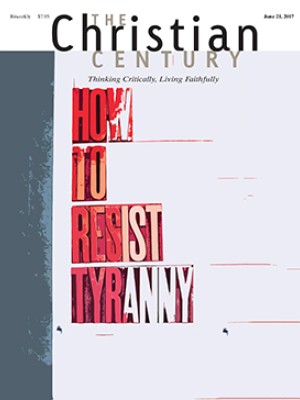Churches see benefits in sponsoring art shows
Gillian Ross recalls a time when visual art largely wasn’t welcome in the churches she knew.
“There was just that general feeling that the arts were a little bit risqué and maybe not appropriate for the church to be involved with,” said Ross, an artist and gallery owner who directs the Grace Chapel Art Gallery in Lexington, Massachusetts, which is connected to an evangelical megachurch.
Today many churches again want to support artists. With a few moves to turn bare walls into venues, some displays complement lessons taught in worship: one church asked members to submit art pieces in response to a sermon series on thriving. A show at a Fort Wayne, Indiana, church featured local artists’ creations from discarded objects and materials.
Read our latest issue or browse back issues.
In one indicator of a growing trend, some 400 churches with gallery ambitions have bought Seeing the Unseen: Launching and Managing a Church Gallery at $30 per copy, according to Cameron Anderson, executive director of Christians in the Visual Arts, which publishes the handbook. A precursor edition didn’t sell as well ten years ago, even though it listed for only $5.
“There’s something happening out there,” Anderson said.
James Disney, pastor of Bethlehem Lutheran Church in Minnetonka, Minnesota, which opened its gallery in 2013, organizes five or six shows a year. For some, he seeks out local Christian artists who adorn the fellowship hall with images consistent with the liturgical season. The art enhances parishioners’ spiritual lives, Disney said, by giving them new ways to see and think about familiar subjects.
“When we have receptions for the artists, they invite their friends and co-workers and people they met at the grocery store,” said Disney. “We get a lot of remarks about, ‘How amazing that you’re doing this! Wow, this is incredible!’ It sort of reshapes their vision about what church is about.”
Lincoln Berean Church, a megachurch in Nebraska with five art galleries and nearly 100 works on display, sometimes puts out a call for photographers or painters to capture a particular theme for an upcoming show. One photography show featured tattooed church members alongside placards explaining what their tattoos mean to them.
“The idea was to help our congregation look beyond what you might see physically and make a judgment, but instead get to know the person,” said Ann Williams, director of visual arts at Lincoln Berean. “You can maybe use the artwork that somebody is wearing to start up a conversation and talk with them.”
Launching a gallery can be as simple as installing a few hooks in a hallway, but ambitious ones require more investment. Outfitting a space might cost $1,000 for track lighting and other features, said Scott McElroy, director of the New Renaissance Arts Movement, a nonprofit that equips churches to utilize arts in ministry.
Churches have little trouble attracting quality artists for two big reasons: they offer visibility and financial opportunity. Unlike commercial galleries, most churches don’t broker sales and don’t charge commissions. Visitors buy directly from exhibiting artists, who can keep every penny but sometimes donate a portion to the host church.
Perhaps most challenging is figuring out what’s inappropriate for a church to display. First Presbyterian in Fort Wayne generally allows nudes, but it denied one racy depiction of a prostitute in a Bible story. Lincoln Berean has a no-nudes policy to be in solidarity with congregants fighting pornography addictions. Bethlehem Lutheran drew the line at a photo of a woman dressed like a zombie holding a sign: “Jesus was a zombie.”
“The picture is a wonderfully clever play on all these overly abundant bloody crucifixes we’ve all seen Jesus impaled on,” Disney said, “but I couldn’t put that on the wall of my church and let five-year-olds come out of Sunday school and look at it.” —Religion News Service





